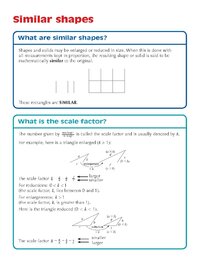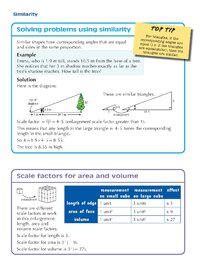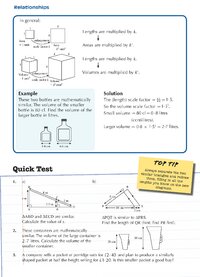You are using an out of date browser. It may not display this or other websites correctly.
You should upgrade or use an alternative browser.
You should upgrade or use an alternative browser.
How many kilograms of sugar will the bigger one hold?
- Thread starter chijioke
- Start date
The implicit assumption in the question is that the density of sugar is invariant. Whether that is a physical fact I do not know. I am embarrassingly ignorant of physical chemistry. But if it is a fact (or a reasonanle approximation, then mass and volume are in a linear relationship.The mass of sugar the drums can hold are their capacities? How does their capacities affect their volume?
View attachment 35631
The Highlander
Senior Member
- Joined
- Feb 18, 2022
- Messages
- 1,195
(Capacity is really just another word for volume; they are often used interchangeably.)The mass of sugar the drums can hold are their capacities? How does their capacities affect their volume?
This problem is only slightly more 'complicated' than the other question (that you have now (finally, phew) arrived at the correct answer for; see here) simply because they are giving you a mass (weight, if you prefer) in kg to deal with instead of a volume to deal with.
But the amount (mass or weight) of a substance that a container can hold is directly proportional to its volume, ie: if a 1 litre cylinder holds 1kg of sugar then a 2l cylinder will hold 2kg of sugar and a 4l one will hold 4kg, etc.
(NB: In real life such containers are unlikely to hold those (exact) quantities of sugar, of course, because I very much doubt that the density of sugar is 1 g/cm³; I use those figures purely for illustration.).
So all you need to do is find the relative volumes of the two containers via the cube of the ratio of any corresponding dimension(s) that you are given for these, once again, similar containers (as was demonstrated for you here) and that factor will enable you to (directly) calculate the weight of sugar the larger container will hold.
(In essence, the weights equate to the volumes.)
So please now show us your working to prove that "C" is the correct answer (before this thread runs onto several more pages too!).
Last edited:
Dr.Peterson
Elite Member
- Joined
- Nov 12, 2017
- Messages
- 16,863
To put it a little differently, for any given substance (under given conditions, so that the density is constant), mass or weight is proportional to volume, just as, for similar shapes, volume is proportional to the cube of linear dimensions.The mass of sugar the drums can hold are their capacities? How does their capacities affect their volume?
So this problem is about proportionality twice. That's all it is.
Noted.To put it a little differently, for any given substance (under given conditions, so that the density is constant), mass or weight is proportional to volume, just as, for similar shapes, volume is proportional to the cube of linear dimensions.
So this problem is about proportionality twice. That's all it is.
So here I am. Ratio of height of small drum to big drum = [math]\frac{2}{3}[/math]Because I am dealing with volumes, I will have to cube the ratio and increase 800 gram in that ratio:So please now show us your working to prove that "C" is the correct answer (before this thread runs onto several more pages too!).
[math]\frac{3^3}{2^3}×800=2700[/math] and it becomes visible that the big drum holds 2700 grams sugar.
The Highlander
Senior Member
- Joined
- Feb 18, 2022
- Messages
- 1,195
That's correct.\(\displaystyle \frac{3^3}{2^3}×800=2700\) and it becomes visible that the big drum holds 2700 grams sugar. ✔
(Although it did say the answer should be in kg, ie 2.7; just a minor adjustment required there ?)
I trust you are getting the hang of these now and should be able to tackle any future problems like these confidently yourself. ?
Yes. I never took my time to look at that instruction too. [math]1 kg= 1000~ g[/math] So, [math]2700~g=\frac{2700~g}{1000~g}=2.7~kg[/math] Though, I wondered why the 2700 g I obtained was included in the option hiddenly -(don't mind the English as long as the message is passed across). I can now clearly see the solution as 2.7 kg. Thanks for that eye opener.(Although it did say the answer should be in kg, ie 2.7; just a minor adjustment required there ?)
Yes!I trust you are getting the hang of these now and should be able to tackle any future problems like these confidently yourself. ?
The Highlander
Senior Member
- Joined
- Feb 18, 2022
- Messages
- 1,195
Please see here.Try the classic approach and let us see your final answer!
The classic we go.Try the classic approach and let us see your final answer!
H= height of big cylinder
h=height of small cylinder
d=diameter of small cylinder
D=diameter of big cylinder
V=volume of big cylinder
v=volume of small cylinder
R=radius of big cylinder
r=radius of small cylinder
[math]\frac{h}{H}=\frac{d}{D}[/math][math]v=\pi{r}^2h=\pi{\left(\frac{d}{2}\right)}^2h[/math]We are given the height and volume of small cylinder, so we can find its diameter.
[math]d=\sqrt{\frac{4v}{\pi h}}[/math]Back to the classic formula
[math]\frac{h}{H}=\frac{ \sqrt{ \frac{4v}{\pi h} } }{D}[/math]Now we can find the diameter of the big cylinder.
[math]D=\frac{ H\sqrt{\frac{4v}{\pi h} } }{h}[/math][math]= \frac{ 3\sqrt{\frac{4×800}{2\pi} } }{2}=33.85137501 ~m[/math]We can now find the volume of bigger cylinder.
[math]V=\pi R^2H=\pi{\left(\frac{D}{2}\right)}^2H[/math] [math]= \pi{\left(\frac{33.85137501}{2}\right)}^2×3[/math] [math]\approx 2700g[/math]Since the solution is required in kg. 2700g = 2.7 kg
The Highlander
Senior Member
- Joined
- Feb 18, 2022
- Messages
- 1,195
@chijioke,The classic we go.
H= height of big cylinder
h=height of small cylinder
d=diameter of small cylinder
D=diameter of big cylinder
V=volume of big cylinder
v=volume of small cylinder
R=radius of big cylinder
r=radius of small cylinder
[math]\frac{h}{H}=\frac{d}{D}[/math][math]v=\pi{r}^2h=\pi{\left(\frac{d}{2}\right)}^2h[/math]We are given the height and volume of small cylinder, so we can find its diameter.
[math]d=\sqrt{\frac{4v}{\pi h}}[/math]Back to the classic formula
[math]\frac{h}{H}=\frac{ \sqrt{ \frac{4v}{\pi h} } }{D}[/math]Now we can find the diameter of the big cylinder.
[math]D=\frac{ H\sqrt{\frac{4v}{\pi h} } }{h}[/math][math]= \frac{ 3\sqrt{\frac{4×800}{2\pi} } }{2}=33.85137501 ~m[/math]We can now find the volume of bigger cylinder.
[math]V=\pi R^2H=\pi{\left(\frac{D}{2}\right)}^2H[/math] [math]= \pi{\left(\frac{33.85137501}{2}\right)}^2×3[/math] [math]\approx 2700g[/math]Since the solution is required in kg. 2700g = 2.7 kg
It seems clear (to me at least) that the exercises you are attempting are designed to test students' knowledge & understanding of Similarity & Scale Factor and their ability to use these in "real life" problems.
That is why I commented that the above 'method' was "complete overkill" and not what was expected from you by whomever set you these exercises.
You have displayed (repeated) struggles to get to grip with the 'correct' method to solve these problems so I have put together information covering the main points you should know (& have been taught/learned, beforehand) in order to tackle these problems.
(I have also attached a little booklet that you can download to your device for future reference offline.)
Please study the three 'pages' below paying particular attention to what Similarity and a Scale Factor (k) are (& how to use them) and, specifically, the (appropriate) uses of k, k² & k³.
(You should also attempt the "Quick Test" before you look at the answers. ?)
The Highlander
Senior Member
- Joined
- Feb 18, 2022
- Messages
- 1,195





